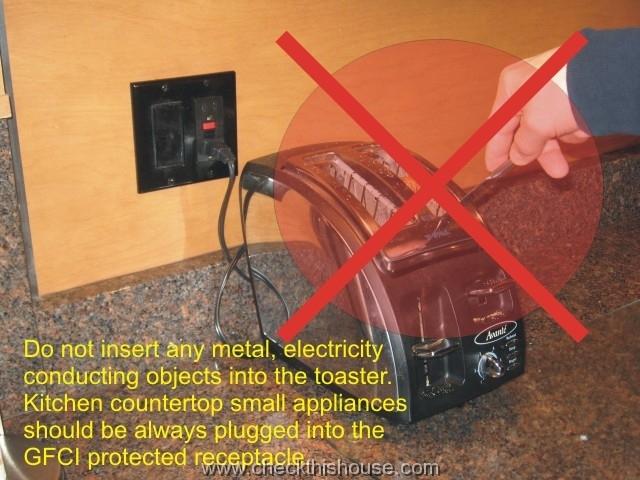The simplest explanation of the GFCI (Ground Fault Circuit Interrupter) Receptacle Purpose would be:
GFCI devices save lives by limiting the duration of electrical shocks.
The real life scenario: Let’s say that you’re using a metal knife or fork to pull out your breakfast from the toaster which is still turned on. By touching the interior electrical components, you may become an extension, the path for the electrical current.
If you are lucky to have the toaster plugged into the functional, properly installed GFCI receptacle or GFCI breaker protected receptacle, it will detect that “leaking” current and disconnect the power as fast as 1/40th of a second.
This is fortunately less time that it takes the electrical current to cause damage to our body. Without the GFCI protection… well, you may be out of luck. The electrical current of 30-200mA (200mA is a typical night light current) is capable of causing your heart arrhythmia, eventually stopping your heart and ceasing blood circulation within a few seconds.
GFCI Location History: GFCI (Ground Fault Circuit Interrupter) electrical outlets where first introduced in US in early 70’s. Still in the testing stage, and under development, GFCI outlets where causing a lot of confusion and aggravation in the beginning of their implementation. Becoming more advanced and safer over a few decades of existence, those inexpensive GFCI outlets are currently protecting our lives in various locations in our properties.
The table below shows an introduction of various GFCI required locations and conditions over the 30 year period. However, you should always apply the latest code requirement to your situation. It’s required not because somebody is trying to make a few bucks on you, but because your life might depend on it.
| History of GFCI Requirements Introduced by NEC (National Electrical Code) |
|
| Year of NEC Publication |
New GFCI Locations or Conditions Concerning GFCI Applications Introduced in NEC Publication |
| 1971 |
|
| 1973 |
|
| 1974 |
|
| 1975 |
|
| 1978 |
|
| 1981 |
|
| 1984 |
|
| 1997 |
|
| 1990 |
|
| 1993 |
|
| 1996 |
|
| 1999 |
|
| 2003 |
|
| 2008 |
GFCI Locations in Residential Buildings |
That’s about it, some basic GFCI outlet purpose and GFCI location history.



I am looking for the first requirement for GFCI protection of receptacles in a commercial repair garage. any idea when this req. appeared in the NEC?